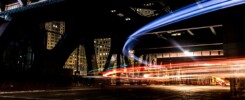Johannesburg’s infamous traffic congestion is both a challenge and an opportunity.
Recent statistics paint a vivid picture of just how much time is spent on the road by commuters. According to the 2023 Global Traffic Scorecard by INRIX, Johannesburg drivers lose an average of 140 hours annually in traffic. This figure underscores the city’s dire need for innovative solutions to maximize productivity and engagement during these gridlocked hours. For businesses, however, this presents an untapped avenue: a captive audience with nothing but time on their hands.
With thousands of vehicles crawling through high-traffic routes every day, the captive audience of frustrated drivers and passengers offers a unique advertising space. Traditional billboards and radio ads have long been the go-to mediums for engaging these audiences. However, the emergence of LED rear window car screens marks a significant evolution in Out of Home (OOH) advertising. These screens provide dynamic, eye-catching displays that can target not only drivers but also secondary audiences like pedestrians and cyclists.
Why LED Rear Window Screens?
- Unmatched Visibility: Positioned on the rear windows of vehicles, these LED screens are at eye level for motorists. Whether stuck in bumper-to-bumper traffic or cruising through stop-and-go zones, ads displayed on these screens remain highly visible.
- Dynamic and Flexible Content: Unlike static billboards, LED screens allow brands to rotate messages throughout the day, tailoring content to specific times, locations, or even events. Morning traffic could feature coffee promotions, while evening congestion might highlight entertainment options.
- Wide Reach: Vehicles equipped with LED screens become moving billboards, extending the reach beyond their immediate location. This mobility ensures that your brand visibility isn’t confined to a single area but spans multiple high-traffic zones throughout the day.
- Cost-Effective: Compared to other advertising formats, LED rear window screens offer a competitive return on investment. Their dynamic nature allows multiple brands to share the space, further reducing costs while increasing exposure.
- Engaging Secondary Audiences: While targeting drivers, these screens also capture the attention of pedestrians, joggers, and cyclists along the route. In bustling city centers or pedestrian-heavy areas, this secondary audience can significantly amplify your brand’s reach.
The Numbers Don’t Lie
Johannesburg’s traffic hotspots—such as the M1, N1, and N3 highways—are home to over 1 million daily commuters. With the average South African spending 50 minutes commuting daily, businesses have a window of opportunity to engage potential customers with compelling, memorable content. Research shows that OOH advertising can increase brand awareness by up to 47% and drive action by 60%. Adding dynamic LED screens to the mix enhances these metrics, thanks to their ability to captivate and resonate with audiences in real-time.
For brand managers, digital media houses, and decision-makers, the message is clear: LED rear window car screens are not just another advertising platform—they are the future of OOH advertising in congested cities like Johannesburg. They offer the chance to break through the noise, engage a captive audience, and create memorable brand experiences.
As Johannesburg’s traffic shows no signs of easing, the demand for innovative advertising solutions will only grow. Investing in LED rear window screens now places your brand at the forefront of this advertising revolution, ensuring maximum visibility and impact in an increasingly crowded marketplace.
So, the next time you’re stuck in traffic, look around. That slow-moving sea of cars represents more than just frustration—it’s a goldmine of opportunity for brands ready to innovate. Make your move now and let your brand be the one that stands out in the crowd.


